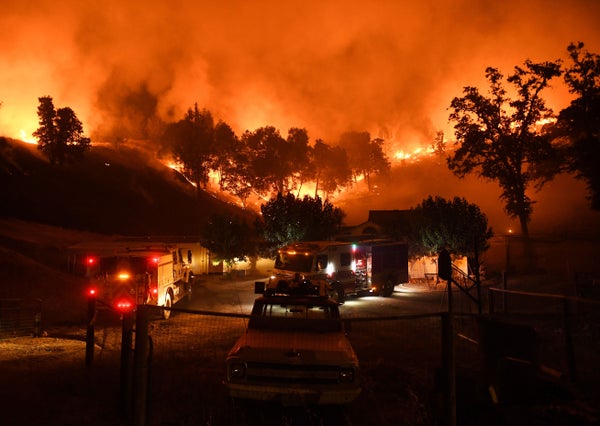CLIMATEWIRE | The amount of land scorched by wildfires in California has been on the rise for decades, and human-caused climate change is almost entirely to blame.
A new study, published Monday in Proceedings of the National Academy of Sciences, finds that California’s summertime burned area has increased fivefold since 1971. And it won’t stop there — it could grow by another 50 percent by the year 2050.
The study finds that rising temperatures and declining precipitation, fueled by human emissions of greenhouse gases, are the primary culprit. Increasingly arid conditions have provided a surplus of dry fuel for fires to consume, causing bigger and more intense blazes as time goes on.
On supporting science journalism
If you're enjoying this article, consider supporting our award-winning journalism by subscribing. By purchasing a subscription you are helping to ensure the future of impactful stories about the discoveries and ideas shaping our world today.
Natural fluctuations in the Earth’s climate, on the other hand, have had little to no influence on California’s worsening fire season. The study makes it clear that human activity is at fault.
It’s a kind of research known as attribution science, a field of study that investigates the links between climate change and extreme weather events. Attribution studies typically use climate models to conduct simulations comparing the real world with an imaginary world where human-caused climate change doesn’t exist. These simulations allow scientists to parse out the influence of global warming.
In this case, the researchers — led by scientist Marco Turco from the University of Murcia in Spain — used a special kind of wildfire model to carry out their study. They found that simulations accounting for the influence of climate change neatly matched their observations of California’s wildfires, including a strong increase in burned area over the last few decades.
But when they removed human-caused warming from the simulations, the trend all but disappeared. The simulations with climate change produced 172 percent more burned area since the 1970s.
The impact grew worse with time, as well. The trend significantly strengthened around the turn of the century, the models suggest, with the influence of human-caused climate change becoming really clear around 2001. Natural climate fluctuations, on the other hand, have “no detectable influence” after that point.
The researchers also looked ahead to the future. They conducted an additional set of simulations projecting additional increases in temperature as time goes on. They also accounted for the fact that California doesn’t have an endless supply of dry fuel available — some of it will get burned up as wildfires worsen in the coming years.
Even accounting for this kind of fuel feedback, they found that burned area likely will increase by anywhere from 3 to 52 percent under moderate to severe future climate change scenarios. The more moderate scenario is in line with the amount of warming scientists expect if world leaders don’t swiftly ramp up their efforts to reduce global greenhouse gas emissions.
Still, there's an opportunity in the findings. The study suggests that less warming may result in less burning — a warning to policymakers that immediate efforts to mitigate climate change are key to addressing California’s wildfire problem.
At the same time, the researchers note, California’s blazes have been worsening for decades. That means better adaptation to the current fire landscape — and the pursuit of new efforts to make California’s natural landscapes and human communities more resilient to wildfires — is also critical.
Reprinted from E&E News with permission from POLITICO, LLC. Copyright 2023. E&E News provides essential news for energy and environment professionals.
